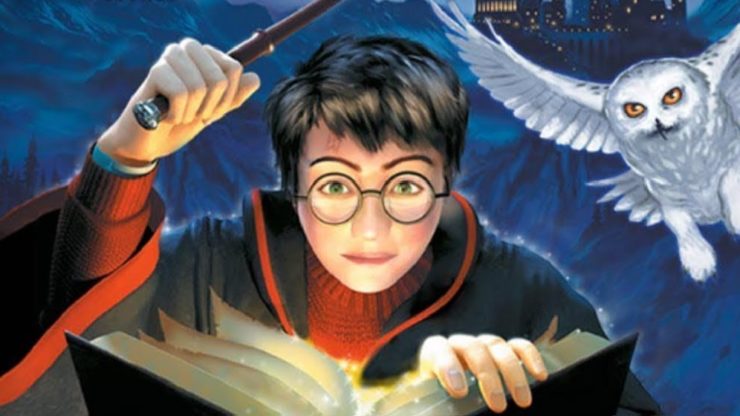What can I say? Sometimes I am nostalgic.
A couple of weeks ago, I just got this craving (that we all get regularly) to read Harry Potter for the ‘n’th time. And yeah, I could have started another read, but another thought occurred to me: Why don’t I play the games instead, to get my Harry Potter fix? I had previously played the first four games (on PC), and I would like the opportunity to replay them, as well as play the rest.
So I started doing my homework first, to read a bit about them and refresh my memory. I found out that for the first three games in the series, there was a different version of the game for each of my favorite platforms: PC vs PS2 vs PS1 (where applicable).
Since I had originally played on PC, I thought why not try the other platforms as well.
Here is my experience with the first game, “Harry Potter and the Philosopher’s Stone”. As everybody is probably aware by now, the game (as well as the book and movie) was marketed as “Harry Potter and the Sorcerer’s Stone” in the US.
For this review, I played it on PS1/PC/PS2.
PS1 Version:
Developed by Argonaut Games, the PS1 version is by far the most outdated, as it resided on a console that was nearing its end-of-life. That didn’t stop me from playing it. Even though I could have grabbed my PS1 and play it on the TV, I found it more comfortable to just fire up an emulator (Duckstation) and play it via a controller on my PC.
Also, I think I need to talk to my therapist, as PS1 Ron Weasley might want to hurt me:
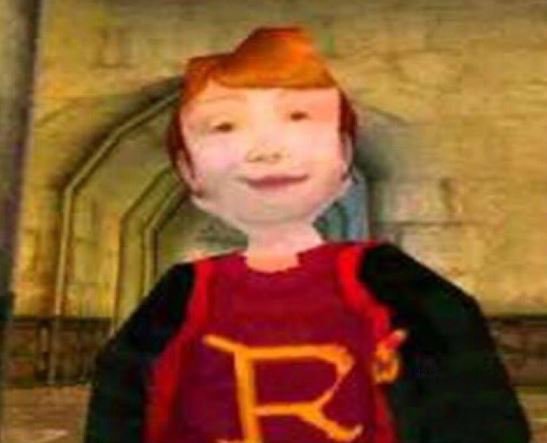


The Good:
Voice acting is pretty good. Much better than the PS2 version anyway (I am going to get to that one later). The external environments are more diverse and more colorful than the PS2 version as well, although the interior of Hogwarts is pretty basic.
Creatures/Enemies/Spells are really diverse. This version of the game has spells that the others don’t. There is one called Verdimillious, which I haven’t really encountered in any PC version if I remember correctly. It’s also pretty useless, as you only use it during that Defence against the Dark Arts lesson + a room adjacent to the classroom.
There is little other extra good to say about it. In my opinion there are very few things that remain enjoyable in this game after 20 years. I wonder if it was enjoyable to begin with, but let’s move on to…
The Bad:
Worst graphics of all three, but expected given the PS1 level of graphics.
Same jumping problem as in PS2, there is no jump button and Harry can decide to jump on his own. On top of that, Harry doesn’t stop when you stop, he acts like he’s on ice, stops with a delay after you raise your thumb from the button. This proves problematic on ledges. You will fall more than you would like.
Timed challenges before every lesson. Basically a mechanic to decide if you’re late for class or not. At the beginning they are not as challenging, but towards the end they are inhuman and you more than likely prefer to lose 5 points from Gryffindoor than go through that shit again.
Also it feels like this game has the worst minigames in gaming history. Besides the timed challenges before lessons, you get a Gringotts level composed entirely of minigames, out of nowhere, in the middle of the game, when Harry needs to go with Hagrid to Diagon Alley. This basically never happens in the book, or it happens but at the beginning, not during school year. I am not sure the game references the same Diagon Alley visit, but I can confirm the Gringotts levels are criminal. You basically have to clear 3 vaults and you have a timed challenge before each of them, which occurs on a slippery surface, plus each of the vaults consists of a minigame where you have to collect coins with a cart. Kinda looks like a bad version of the Half Life intro. And it’s extremely difficult, it took me a while to clear them. Luckily, I was emulating the game, so I could slow down emulation and pick the coins up much easier. The 3rd Vault was atrocious though, on 70% emulation speed that shit was way too fast for me. I wonder what kids if any managed to finish this succesfully on PS1 back in the day. You need badass reflexes for this one.
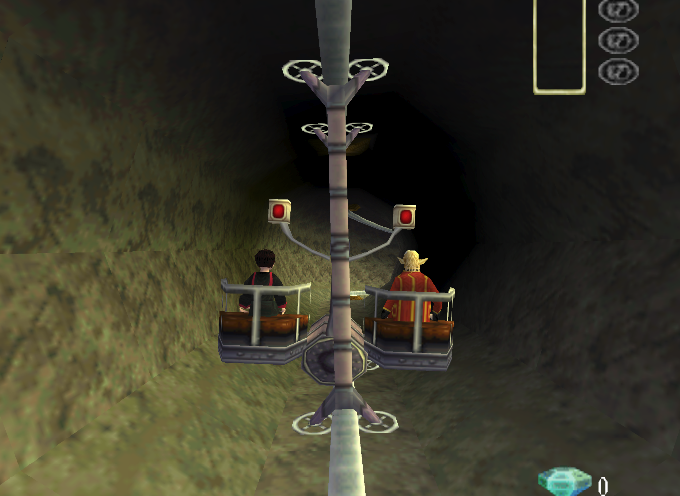
Next to Gringotts, after you exit the bank, you have to visit 3 shops to get stuff for Hagrid. Two are easy, but the Ollivander’s one is murder, as you have to follow a Peacock and get 3 feathers from it. And he runs like hell. I couldn’t do it on regular speed, so again I had to use the emulation hack and for some reason it helped, since I could see “in advance” (read: earlier) where the peacock shifted direction, and that translated into me going in the right direction earlier rather than later instead of missing the direction completely at full speed. I could follow it better on slower speed, and the more you stay close to it, the easier it is to get the feathers (there’s a bar that fills up if you stay on top of it, and it has to fill up three times).
It feels like of all three games this is the game which goes the furthest from the plot of the book. At some point Snape actively lays traps for Harry, which never happens in the book. Also, you have the final Quidditch match AFTER you defeat Voldemort, which is kind of stupid. There are multiple inconsistencies, but I won’t list them all.
The only real problem with the ending though is the fact that the entire sequence at the end, starting with Fluffy and ending with Voldemort, has no auto-save. If your game gets stuck and you need to restart your Playstation, you loose all progress. And there’s a bug during the troll sequence where if you die, the game gets stuck during the death animation. Luckily I was emulating it and after it happened to me the first time I kept saving states so that I don’t have any problems if it reoccurs. It was annoying, because I had to replay around 2 hours of gameplay, and the chess part isn’t exactly easy, but I made it in the end.
This is also the only game with a heavy accent on platforming rather than puzzles. And for a game without a jump button, it sure involves jumping mechanics a lot. I am not sure that a platforming experience is what you would look for in the Harry Potter franchise though, so I am a bit conflicted about that. Besides, it feels it like relies too much on minigames and too little on actual gameplay. Like the developers took the easy way when creating it, instead of being more inventive.
This is the only game of the three that I am sure I would never replay. It got old in a not-so-nice way.
PC Version:
Developed by KnowWonder in 2001 (which was afterwards bought out by Amaze Entertainment and later by Foundation 9), the game is nothing short of a gem.
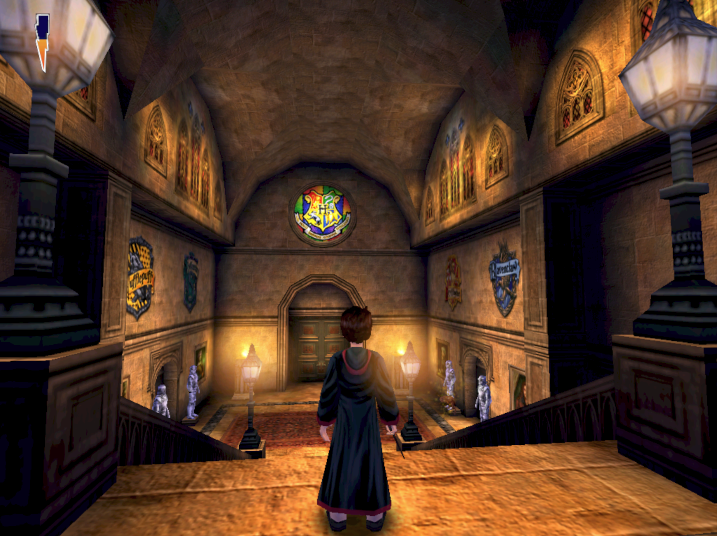
The Good:
Best atmosphere of all three, definitely felt like the game I grew up with. I simply love to play this game, I loved the internal Hogwarts architecture, which really feels “magic” (see above), as opposed to the dull PS1 version, or the lackluster PS2 version, which even though has a more ambitious structure, it lacks the “magic” feeling of the PC version.
Out of all three versions which obviously had creative freedom in regards to Hogwarts Castle, I feel like the PC version had the best outcome, in spite of what would be perceived as somewhat outdated graphics nowadays. The fact that it retains the same magic today as it did back then shows that it’s a game made with love. Games based on books/movies are usually either very bad or very good. I love the fact that they exist, because I believe they stimulate the developers to be inventive, and I believe the PC version of Harry Potter and the Philosopher’s Stone is one of the good results.
When I played it back in the day, it felt like the hardest of the first four games (played them all on PC at that point) and was the only one where I needed help with the ending, as I couldn’t defeat Quirrell alone (my brother did it). But nowadays I went through without any issues, and even though the final fight did possess some challenge, I did overcome it in the end.
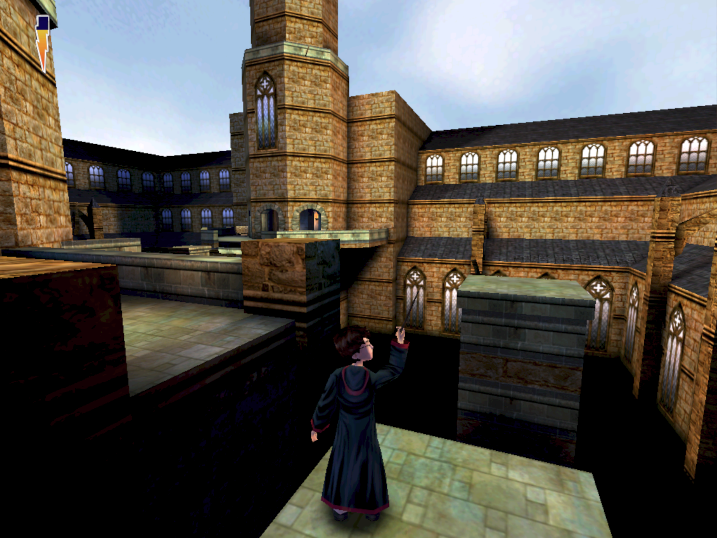
Granted, during one of the challenges, not during free play,
but still it goes to show how much work was put in textures as opposed to PS2 version.
I can say wholeheartedly that the PC version has the greatest replayability value of all three.
The Bad:
Lackluster menu interface, as well as weak Folio Magi system. No posibility of backtracking to get your missed Wizard Cards. Out of all versions, the PC one is the one with the least backtracking options, so if you miss something, it’s more than likely lost for that playthrough.
Also the classes are kind of annoying – you have to follow patterns with the mouse in order to learn spells, and depending on how good you do it, you earn points for Gryffindoor. It’s extremly hard to get a perfect score, but you can get close enough. The challenges though are extremely fun, and I particularly love how Lumos works here.
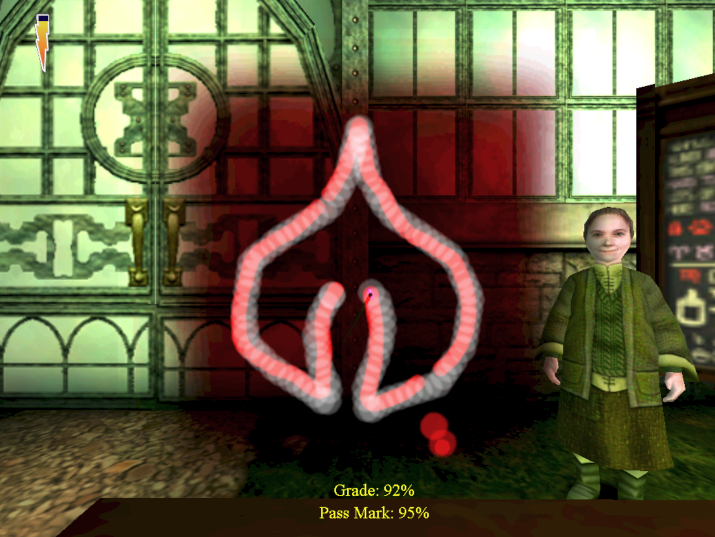
The game itself can feel a little outdated for the modern player, albeit not to the same degree as the PS1 version, however if you are a retro gamer you will overcome this feeling easily and get absorbed into the game’s world without problems. It definitely has the best gameplay and atmosphere of all the three versions.
PS2 Version:
This one is mostly a remake/retelling, since it came out in 2003, 2 years after its counterparts on PC and PS1, and 1 year after Chamber of Secrets (the second game in the series). It was developed by Warthog Games and it was heavily criticized for borrowing many things from PS2 Chamber of Secrets (developed by EA UK). But is it a bad game? Let’s see.
The good:
PS2 version of the game is much more accessible from a gameplay point of view. It also feels as if it’s the easiest to play of the bunch, in spite of the fact that the health restoration mechanic suffers and it has a few other annoying mechanics (see “the bad” section).
“Death” is not as punishing as in the PC version. There are no save spots, you can save whenever, which is a big plus, especially for a console game, and on top of that if you fall of a ledge and die it puts you right back on the ledge. Same for getting killed by enemies, puts you right next to them and if you killed some, they remain dead. This system is very good for the casual gamer and for children, as you don’t lose time retracing your steps.
You have a store to buy things from Fred & George Weasley in exchange for Bertie Botts Beans. It’s in a toilet, but it’s still a store. And during the day it is full of Beans laying around, so you can get some back. The store gets “stored” fast though, as you deplete everything in it after a couple of day-night sequences.
Also this game has the most extensive Wizard Card system, you can actually trade cards with other students, and has all 101 cards that you can collect, as opposed to the other two games, with 25 (PC) and 17 (PS1) cards respectively. Just make sure you complete all the trades prior to the final night, as you won’t get another opportunity afterwards – there is no post-game segment, even though there is free roaming in the game.

Puzzles are very interesting and they follow logic. I found the puzzles to be the most interesting thing of the game and the one element which kept me interested until the end. Internal Hogwarts architecture is very nice on this version, clearly ambitious in design, which is expected considering it came out two years after the PC and PS1 versions. The textures are a bit washed out though.
The game is the most faithful to the original story, even if it lacks certain things.
For example, this is the only game in which they make the Nicholas Flamel connection by reading the back of Dumbledore’s Wizard Card. Also, I noticed at the end of the year, Dumbledore gives points to each of the three kids: Harry/Hermione/Ron, as opposed to the other versions where Harry is the single one who takes points.
Also in this version Gryffindoor can actually come on top with house points at the end of the year even before Dumbledore gives away his final points. Although not story-accurate, makes it interesting that the game gives this opportunity. It does make for an awkward endgame, since Dumbledore mentions the hierarchy, after which he implies things might change and gives away his final points, at the end of which the Gryffindoor team is very happy, although they were already in the lead from the start.

The bad:
I am going to start from the end. The scene with Dumbledore giving away points during the endgame takes place in Gryffindoor tower, as opposed to the Great Hall in the PS1 and PC versions. I found this a little anticlimatic, since only Gryffindoors are there to witness it. Also, Ron says afterwards to go to the Great Hall for the ceremony, and that he feels confident they have chances to beat Slytherin this year. WHEN THEY HAD ALREADY BEATEN SLYTHERIN, AS FINAL POINTS WERE ALREADY ALLOCATED. The game breaks logic quite a few times.
As previously stated, items which restore health restore too little health per item, and 90% of the game you have less than half your maximum health volume.
Dialogues suffer sometimes, as characters tend to state random out-of-context phrases which don’t fit the situation, e.g. Ron saying “Let’s go to Hagrid”, randomly talking about how Snape is secretly into the dark arts, and afterwards completely dropping the subject and getting back at Hagrid. This is mostly a technique used to offer context to people that haven’t read the books or seen the movie (so… people who do not exist?), but it’s poorly implemented.

The window is a nice touch, but the textures are bland, and look nothing like Hogwarts is described.
Just like in the PS1 version, Harry can’t jump by himself. There is no jump button, he jumps from platform to platform when you go towards the edge. This can prove problematic when you don’t want to jump, as the game sometime decides on its own that you want to jump when you don’t want.
Frustrating element during gameplay: whenever you pick up a Bertie Botts Bean: Harry keeps reacting to it and saying “Yuck! Earwax!” or whatever the flavor the bean has. EVERY. FUCKING. TIME. I found that this is one of the reasons this game has zero replayability on PS2 (or at least, not with sounds on). IMHO. Harry is annoying, as he keeps commenting on every little thing he picks up, except the chocolate frogs for some reason.
Also whenever you break recipients containing beans, some beans remain in out-of-reach places, and as Harry can’t jump you obviously can’t reach them. Design flaw.
Still on the subject of beans, your Bean capacity is limited, and unless you buy an higher-capacity bean bag from Fred & George (ONLY during the night in Gryffindor tower) you will soon find yourself in the impossibility to pick up beans. I was under the impression I had discovered a bug, unaware that the capacity is limited. At least they could have had Harry say his bag is full or something to at least suggest it. He talks enough about every other bean he picks up, but not about the important things. Note if you play it: This is the thing you absolutely need to buy first from the store.

Speaking of Fred & George Weasley, there is an in-game mechanic involving Percy Weasley right before you have access to the store. It is only present during the night (so, at the same time with the store), and if you’re not careful Percy might catch you while trying to get into the store. It’s mostly a pain in the ass mechanic if you are to play by the game’s rules and step lightly at the right moments so he doesn’t hear or see you, but luckily you can just run straight to the portrait with the access hole and if you do it at the right time, you can escape before he has time to react. I got annoyed after 2-3 retries and just tried that, and I found it saves a lot of trouble.
External Hogwarts architecture looks bland and empty, sort of like an unfinished Counterstrike map with no textures. It’s by far the least effort I’ve seen to create Hogwarts in a Harry Potter game. They focused on making vast exteriors (exaggerated!) without bothering to populate them with proper textures. Internal architecture does make it up for it though.

Spells often miss their target, even if you keep R1 pressed to fix a specific target. Especially annoying with Spongify when you have to trigger certain Spongify platforms. This makes the troll battle in the bathroom very troublesome, as you have to keep moving and hit those squares with Spongify, and you’ll miss in 90% of the times. It doesn’t make it more difficult, but it makes it more time consuming.
The troll fights are really annoying, especially since it’s supposed to be only one and in fact you encounter 3 trolls during gameplay, and with the exception of the last one which can be bypassed and as far as I can tell can’t be defeated (he doesn’t have a health bar), the first two act like bosses in the game – you can’t advance without defeating them. What’s more annoying is that you can’t defeat them directly, you can only harm them by casting Spongify on a platform and then they have to hit the platform with their club, which bounces back and hits them in the head. This makes them the most frustrating enemy, as nothing you can do can harm them directly, you have to somehow cast Spongify and then guide them to hit the platform BEFORE the spell wears out. And their behavior is really erratic, they move in circles and follow you, it’s very hard to make a troll directly hit a platform at the right time. This, combined with the scarcity of the health pickups, make the second troll fight extremely hard, because you only have one platform there, as opposed to four platforms in the bathroom fight. I had to actually use cheats here, as it was impossible for me to progress, because I did not have enough health to last me the entire fight.
This is somehow in contradiction with the entire rest of the game, which is pretty much a breeze.
With one dashing exception: The final Quirrell fight. There is nothing to suggest you what to do here, and since there are two sections of the final fight, each with its own rules, you have to find out what to do somehow. In the first instance, he summons 4 ghost dogs (I forget how they are called) and while you can kill them with lumos (it takes a wile though) he keeps respawning them. It took me a while to realize I can use Flipendo on him while he tries to respawn them, and I can actually prevent him from respawning. From that point on I went through the fight pretty much OK, until the second instance. This is when it gets weird. Harry stands in front of the mirror of Erised and Voldemort/Quirrell casts two types of spells: An unknown red one, and Wingardium Leviosa on some stone balls that he hits you with. The trick is when he casts the red one, standing in front of the mirror makes you absorb that magic, and then the RELEASE option appears. Now, pressing RELEASE always damaged Harry for some reason, so I had no clue what I had to do here, so I searched over the internet and found out that YOU NEED TO WAIT UNTIL HARRY’S AURA turns from GREEN to WHITE, and then you can release the energy towards Voldemort/Quirrell and succesfully harm him.
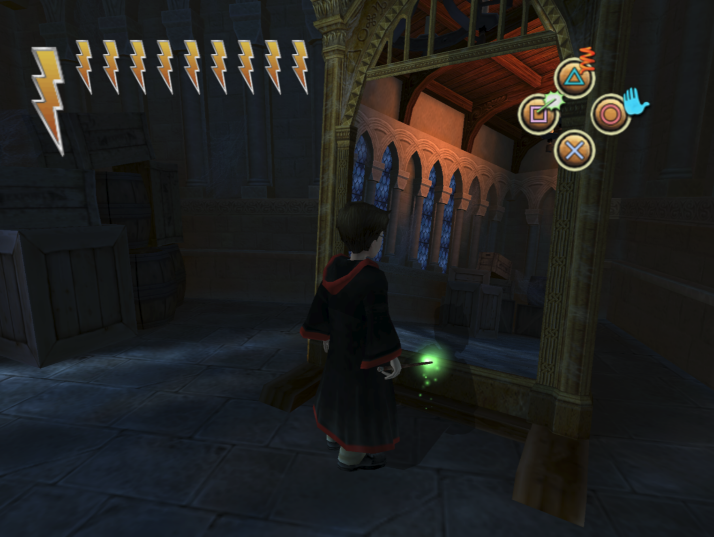
The fact that it introduces a new mechanic at the very end of the game and it doesn’t bother to explain it to the player is extremely frustrating, as you try to do everything you have learned up to that point, but to no effect.
To conclude, the final Quirrell fight is by no means difficult, it’s just EXTREMELY BADLY IMPLEMENTED. It has nothing to do with what you learn up to that point.
Although the PS2 game stands the test of time the best out of all three, the annoying (mini)bosses implementation (trolls and plants) and the final clueless fight, alongside the bland Hogwarts exterior, really mess up what could have been the best and casual-friendliest Harry Potter and the Philosopher’s/Sorcerer’s Stone experience ever.
I might replay this game at some point, as it has some value, but I am pretty sure if I do it I would definitely use cheats to get over the annoying segments like the second troll fight and possibly the giant plants (which I did not mention in this review, but are somewhat annoying as well).
In retrospect, my overall favorite is the PC version of the game, with a PS2 version that came 2 years later a close second, tainted by some questionable design decisions and by a system copied from an already-existent game, which would otherwise have been a great game by itself if not for these flaws.
